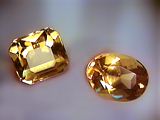![]()
Name:
Beryl

Chem:
Al2Be3(Si6O18)
Aluminum Beryllium Silicate
Crystal:
Hexagonal (often long prisms
Color:
blue
aquamarine
green
emerald
yellow
heliodor
violet-pink
morganite
colorless
goshenite
red
bixbite
Refrac. Index:
1.57 - 1.60
Birefraction:
grn/blue-0.006
yel-0.005
others-0.008
Hardness:
7.5
Spec. Grav.:
2.69 - 2.8
Fracture:
conchoidal
Cleavage:
imperfect
Environment:
granite rocks and pegmatites, hydrothermal deposits
Association:
quartz, spodumeme, cassiterite, columbite and other rare minerals
Locals:
| Columbia | Brazil | Russia | Australia | Mass., Calif., USA | Sri Lankra | Namibia |
Misc:
the name comes from the Greek "berylos", and which means "sweet.". Some varieties fluorescent, insoluble in acids, a very important economic mineral and the major source of beryllium.
Gem info:
An important series of gemstones, Emerald is one of the most expensive stones on the market, the best comes from Columbia and is colored by chromium impurities. The chromium weakens the crystal lattice and produces a highly flawed structure, which makes the stone weak and easily damaged by mechanical force.. It is sometimes oiled to hide the internal flaws.
The best blue, Aquamarine, comes from Brazil today, and can be found in very large, and very clean crystals. The color is caused by iron impurities, and it can be heat treated to enhance the color. It is more expensive than blue topaz, but far less expensive than emerald. Asterism is possible in aqua producing either cats-eye or even star stones.
The rarest beryl is bixbite (red) and is not usually seen in jewelry as it occurs in only very small crystals. The red color is due to manganese, and the best material comes from Utah.
Heliodor (yellow-green) is colored by uranium and is slightly radioactive. Yellow to yellow-orange samples are referred to as golden beryl. True Heliodor is valued by collectors but not seen much in jewelry, the golden beryls are seen often in jewelry but are not as expensive as aquamarine.
Morganite (pink) is one of the more expensive beryls and like virtually all good pink stones draws an excellent price, again not as expensive as emerald, but equal to the best aquamarine. It contains cesium and lithium, but the color agent is a trace of manganese.
Goshenite (clear-colorless) - often used with a metal foil to imitate emerald or aquamarine. Is not used extensively in jewelry and is not expensive.